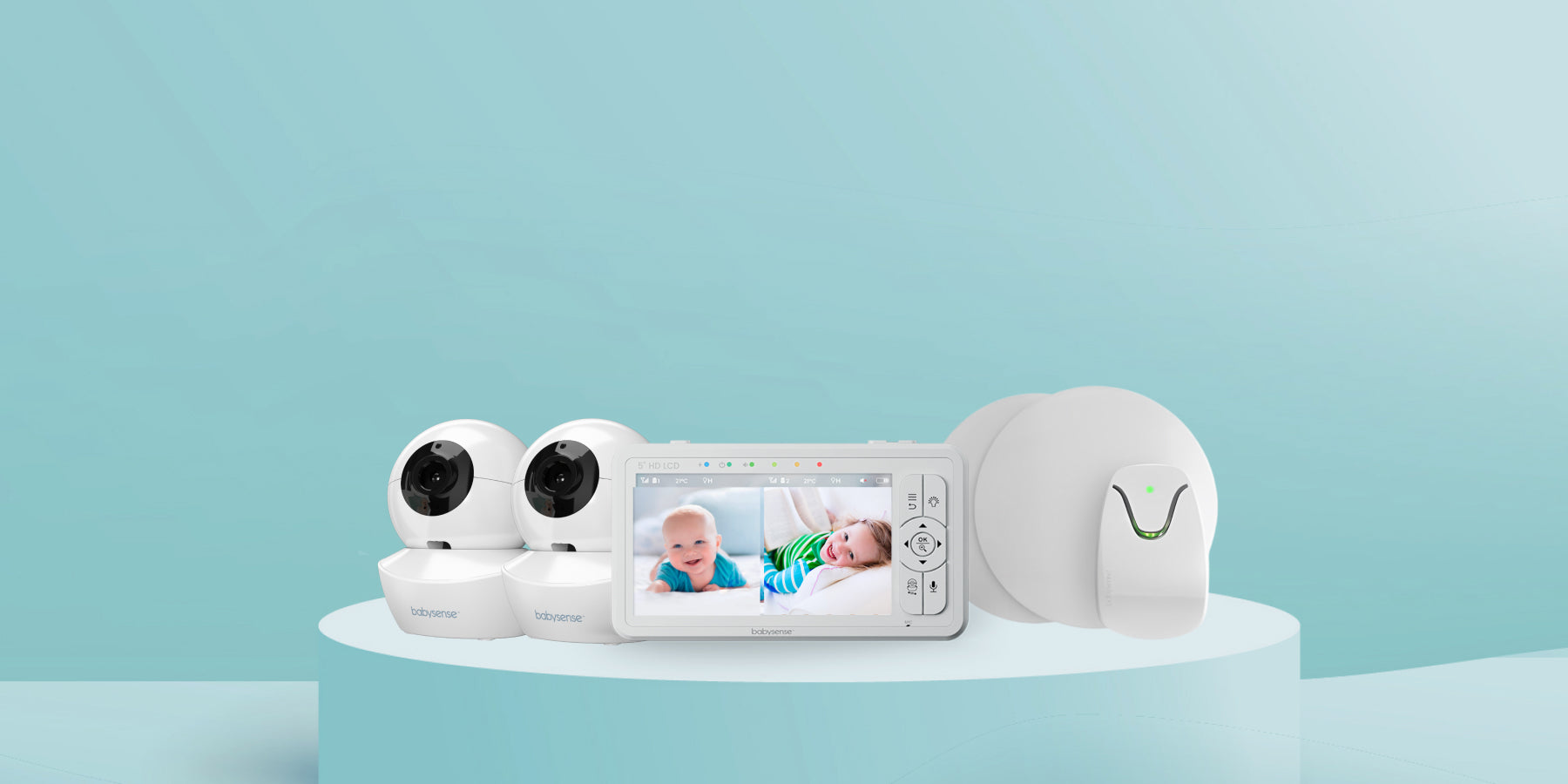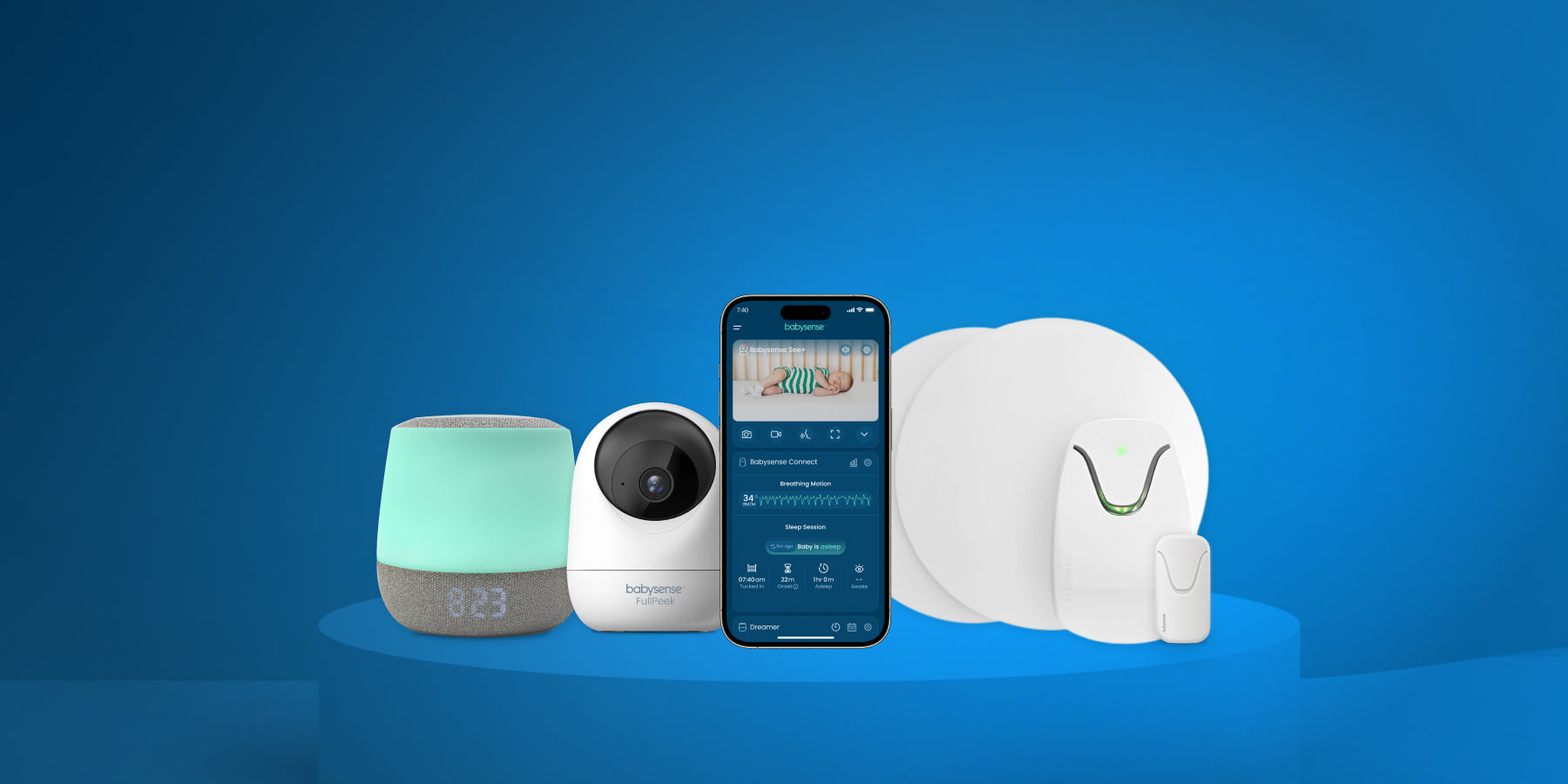It’s common for new parents to worry when they notice their newborn or toddler breathing rapidly while sleeping. In many cases, this faster breathing is normal and tied to a baby’s developing body. Babies aren’t just “small adults” – their lungs, nervous system, and sleep patterns are still maturing, which can make their breathing seem quick or irregular. This article will explain the typical reasons infants breathe fast during sleep, reassure you about normal patterns, and also discuss when rapid breathing might signal a problem that needs medical attention. We’ll cover benign causes (like active REM sleep and an immature nervous system) as well as possible medical causes (such as fever, infections, or congenital issues). With clear facts and guidance, you’ll learn what’s typical versus concerning, so you can rest a bit easier while your baby sleeps.
Normal Breathing Patterns in Babies
Babies naturally breathe faster than older children and adults. A newborn’s normal resting respiratory rate is roughly 30 to 60 breaths per minute, which can appear rapid to a parent watching their chest rise and fall. (For comparison, adults breathe only about 12–18 times per minute.) Even toddlers up to about 2–3 years old normally breathe around 20–40 times per minute during rest. This higher rate is simply how babies’ bodies work – it helps meet their oxygen needs for growth and development.
Several physiological differences explain why infants breathe faster:
-
Small Lungs, Big Needs: Babies have smaller lungs and fewer air sacs (alveoli) than adults, which limits the amount of air they get with each breath. To compensate, they must breathe more quickly to take in enough oxygen and expel carbon dioxide. They also primarily breathe through their noses and have weaker chest muscles. All of this makes their breathing rate higher and sometimes more effortful than an older child’s. In fact, an infant’s oxygen consumption (and overall metabolism) is higher for their size, driving a faster respiratory rate to supply their body. In short, infants have a higher metabolic rate and must breathe faster to support it.
-
Ongoing Lung Development: Newborns are still adapting to breathing air after birth. Their lungs and airways continue to develop through childhood – a child’s lungs aren’t fully mature until about 8 years old. Early on, babies’ breathing can be a bit irregular as their respiratory control matures. Over the first few months, they gradually develop a more regular rhythm.
-
“Periodic Breathing” in Sleep: It’s normal for young infants (especially under 6 months) to display periodic breathing during sleep. This is a pattern where a baby pauses breathing for a few seconds (usually 5–10 seconds) then resumes with a burst of fast breaths. For example, a newborn might stop breathing briefly, then breathe rapidly at 50–60 breaths per minute for several seconds, and then settle back to a normal pace. This cycle often occurs in light sleep and is a reflection of an immature nervous system controlling breathing. Importantly, periodic breathing is common and usually harmless in infants up to about 6 months old. Babies typically outgrow these breathing pauses by the middle of the first year as their brain matures.
Understanding these normal patterns can reassure you that fast or uneven breathing isn’t automatically dangerous. If your baby is otherwise acting well – with normal skin color, good feeding, and no distress – rapid breathing during sleep is likely a normal part of development. The sections below explain some specific benign reasons for fast breathing, followed by potential warning signs and medical causes to be aware of.
Common Benign Causes of Fast Breathing During Sleep
Even in healthy babies, you might observe spells of quick breathing or odd breathing rhythms at night. Here are some of the usual, non-harmful causes of fast breathing in sleeping newborns, infants, and toddlers:
REM Sleep and Active Dreaming
Babies spend a lot of time in REM sleep (Rapid Eye Movement sleep), which is a lighter, active sleep state. During REM sleep, an infant’s breathing often becomes irregular and faster. You might notice your baby’s eyes moving under their eyelids, gentle twitches, or changes in breathing pace. In fact, newborn sleep is about 50% REM sleep (much higher than the ~20% in adults). In REM, the brain is more active (possibly dreaming) and this can lead to rapid, shallow breaths or even little gasps.
It’s during this REM stage that “normal periodic breathing” often happens. The baby may pause for 5–10 seconds, then breathe rapidly (up to ~60 breaths per minute) for 10–15 seconds before returning to a regular rate. The skin color stays normal during these pauses, which is a key sign that this pattern is benign (unlike true apnea where a baby might turn blue due to lack of oxygen). This cycling of irregular breathing in REM sleep is expected in young infants and does not indicate any illness. As babies get older, their sleep cycles mature and such extreme irregularity lessens.
Immature Breathing Regulation (Nervous System Development)
Newborns are born with an immature nervous system, especially the part of the brainstem that regulates breathing. Simply put, the “breathing center” in a baby’s brain is still learning how to maintain a steady rhythm. This is why infants can have irregular patterns like periodic breathing. The brain may intermittently “forget” to breathe for a few seconds, then catch up – which is alarming to watch but usually harmless and self-correcting.
This immature control is more pronounced in premature babies, but full-term newborns can have it too. Over the first weeks and months of life, the brain matures rapidly and breathing becomes more regular. By about 6 months of age, periodic breathing typically disappears as the nervous system matures. If these pauses persist beyond 6 months, you would mention it to your pediatrician, but in young infants it’s part of normal development.
Key point: If your baby occasionally breathes fast and then slow (or pauses) during sleep but resumes normal breathing on their own, and their color and comfort are fine, it is likely due to their immature breathing regulation. Monitoring them (perhaps even recording it) can provide reassurance that they recover on their own quickly. Always lay babies on their back to sleep, in a safe crib, which is recommended safe-sleep practice and also supports their breathing.
Higher Metabolic Rate and Growth Needs
Infants have a much higher metabolic rate than adults – their bodies are growing rapidly and burning energy faster. This means they consume oxygen at a higher rate, which in turn requires them to breathe faster to supply that oxygen. Even at rest (like during sleep), a baby’s body is in high-growth mode, so their baseline breathing rate is elevated to meet those needs.
Additionally, as mentioned before, babies’ lungs are smaller and not as efficient. They have fewer alveoli (air exchange sacs) and a more pliable chest wall. This all results in less oxygen reserve in their lungs compared to older children. So if there’s any slight increase in demand – for example, if the room is a bit warm, or they recently fed and are digesting – they might breathe a bit faster to get enough oxygen. It’s the body’s natural adjustment.
Think of it this way: A baby’s heart rate is normally faster than an adult’s (often 120–160 beats per minute in newborns), and similarly their breathing rate is faster. It’s part of how their physiology keeps up with growth. Rapid breathing in an otherwise happy, pink, feeding-well infant is usually just a sign of a healthy, busy metabolism, not a cause for alarm.
Possible Medical Causes of Fast Breathing
While most instances of fast breathing during sleep are normal, it’s important to know about other conditions that can cause rapid breathing (tachypnea) in babies. Fast breathing can sometimes be a symptom of an underlying issue, especially if it comes with other signs of illness or distress. Here are some potential medical causes:
Fever or Overheating
If your baby has a fever, their breathing will often speed up. Fever raises the body’s temperature and metabolic rate, so the body tries to cool down by breathing faster (and also by increasing heart rate). Faster breathing with a fever is a normal response. You might notice shallow, quick breaths when your child is very warm. Similarly, if a baby is over-bundled or in a hot environment, they might breathe rapidly to release heat.
Monitor the fever and keep your baby comfortably cool (not cold). Treating the fever (with infant acetaminophen if appropriate and advised by a doctor) often will slow their breathing back to normal. On its own, a fever-related fast breathing is usually not dangerous, but fever in young infants (under 3 months) should prompt a call to the doctor for guidance. Always look at the whole picture: a mildly elevated breathing rate with a low-grade fever is expected, but if a feverish child is breathing very hard, has labored breaths, or is lethargic, that warrants medical evaluation.
Colds and Respiratory Infections (RSV, Bronchiolitis, etc.)
Respiratory infections are a common cause of rapid breathing in babies and toddlers. If your little one has a stuffy nose or cough, they may breathe faster to compensate for partially blocked airways. A simple cold can cause some increase in breathing rate, but more notable are infections of the lower airways like bronchiolitis or pneumonia.
-
Bronchiolitis is an infection of the tiny airways (bronchioles) in the lungs, most often caused by RSV (Respiratory Syncytial Virus) in infants. It typically occurs in babies under 2, especially around 3–6 months old. One of the hallmark symptoms is wheezing (a whistling sound) and rapid breathing – usually defined as >40 breaths per minute in this context. You might see your baby’s nostrils flaring or chest muscles retracting with each fast breath. Often, a fever and runny nose precede the breathing trouble in bronchiolitis. If your baby has these symptoms, it’s a good idea to have a pediatrician check their oxygen levels and hydration. Mild cases can be managed at home with fluids, humidified air, and rest, but severe cases sometimes need hospital care (oxygen or IV fluids).
-
Pneumonia (lung infection) can also cause very fast breathing and coughing. Typically the baby would look ill – high fever, possibly deep cough with mucus, and breathing may be labored. Pneumonia in an infant is a reason to see a doctor promptly.
-
Croup (a viral infection causing a “barking” cough) primarily causes noisy breathing (stridor) when inhaling, but severe cases can increase breathing rate, especially at night. Croup’s telltale sign is a barky cough or hoarse cry more than just fast breathing.
Any time your child has a cold or virus, keep an eye on their breathing. Stuffy noses can make babies breathe fast since they are obligate nose breathers – you can help by suctioning their nose or using saline drops to clear the nasal passage. If you notice very rapid breathing along with wheezing or persistent cough, or if baby is struggling to breathe, seek medical advice. For example, wheezing and fast breathing that worsen over 1–2 days could be bronchiolitis, and you should call your pediatrician. Labored breathing with flared nostrils or chest retractions is an emergency sign (more on warning signs below).
Laryngomalacia (Floppy Airway Noises)
Illustration of laryngomalacia, where “floppy” tissue above the voice box partially blocks the airway. This common benign condition causes noisy breathing (stridor) in infants, especially when lying on the back, but usually improves as the child grows.
One possible cause of rapid or unusual breathing sounds in infants is laryngomalacia. This long word means a “soft larynx”, essentially a floppy upper airway. In laryngomalacia, the tissues above the vocal cords are softer than normal and can flop inward toward the airway when the baby breathes in, causing a partial blockage. The result is a distinctive high-pitched squeaky noise (stridor) on inhale.
Laryngomalacia is actually the most common cause of noisy breathing in infants. Often, parents notice it within the first few weeks of life – over half of newborns have at least mild laryngomalacia initially. The good news is that it’s usually harmless and temporary. Most babies with laryngomalacia breathe normally despite the noise and outgrow the condition by 12 to 24 months of age. The sound may get louder over the first 6 months (as babies breathe more forcefully with activity), then it gradually resolves as the airway structures firm up.
How does laryngomalacia relate to fast breathing? Generally, laryngomalacia causes noisy breathing rather than truly fast breathing. However, in some cases if the airway is floppy, the baby might have to breathe a bit harder or faster to get enough air, particularly when asleep on their back or if they have a stuffy nose. You might see the baby’s chest pulling in slightly at the neck with each breath (a mild retraction). The breathing sounds often get louder when the baby is lying down or during sleep, but improve when they’re upright.
Most cases are mild and don’t interfere with feeding or oxygen intake. You should still mention it to the pediatrician if you hear stridor. The doctor will monitor weight gain and breathing. Only about 5-10% of cases are severe, potentially causing feeding difficulties or poor weight gain due to harder breathing. In those rare severe instances, specialists can intervene (for example, a minor surgery) to help the baby’s breathing.
Bottom line: If your infant has a squeaky, raspy inhale sound since newborn period but is otherwise thriving, it could be laryngomalacia – a usually benign issue. It can make their breathing sound alarming, especially at night, but most often it just requires observation until they outgrow it.
Underlying Heart or Lung Conditions
More rarely, congenital (birth) conditions of the heart or lungs can cause an infant to breathe fast, including during sleep. In these cases, the rapid breathing is persistent (not just in REM sleep) and often accompanied by other signs. A few examples:
-
Congenital Heart Defects: Certain heart problems present from birth can lead to tachypnea (rapid breathing) in newborns. When the heart isn’t circulating blood efficiently, the body may not get enough oxygen, and babies breathe faster to compensate. Rapid breathing is one of the common symptoms in infants with significant heart defects, often along with poor feeding, excessive sweating with feeds, or poor weight gain. For instance, a large ventricular septal defect (a hole in the heart) or an obstructive defect like coarctation of the aorta can cause fluid to build up in the lungs or make the heart work harder, resulting in fast, labored breathing. Babies with heart-related breathing issues usually show signs of fatigue (tiring during feeds) and may have a hard time gaining weight. If your doctor suspects this, they will listen for heart murmurs and possibly order tests. Early detection is key – many heart defects are treatable, and managing the heart issue will improve the breathing. Remember that in general, congenital heart disease is uncommon, but it’s something doctors keep in mind if a baby has chronic rapid breathing and other symptoms.
-
Congenital Lung Disorders: Rarely, a baby might have been born with a structural issue in the lungs or airways (such as a cyst or malformation in the lung). These congenital lung anomalies can sometimes cause breathing difficulties or fast breathing from early on. For example, a congenital cystic adenomatoid malformation (CCAM) is a cyst in the lung present at birth; a large one could compress healthy lung tissue and cause respiratory distress. General signs of a congenital lung issue include rapid or labored breathing, wheezing, or recurring pneumonias. The vast majority of these conditions are detected either on prenatal ultrasound or soon after birth, especially if they are large enough to affect breathing. Many babies with small lung malformations have no symptoms at all. So if your baby was full-term and went home healthy, it’s unlikely a hidden lung defect would be the cause of new rapid breathing. Nonetheless, it’s good to be aware that doctors will consider and rule out these possibilities if a newborn has unexplained breathing trouble.
-
Chronic Lung Disease in Preemies: Babies born very prematurely sometimes develop bronchopulmonary dysplasia (BPD), a condition from long-term oxygen therapy that can cause fast breathing and lower oxygen levels. This only applies if your infant had a NICU stay and oxygen after birth. Your pediatrician will guide you on monitoring such babies at home.
In summary, heart or lung conditions can cause a baby to breathe fast, but they usually come with other red flags (blueness, feeding problems, known birth diagnoses, etc.). These are far less common causes compared to normal developmental reasons or routine infections. If your baby has a known condition (like a heart murmur being followed by a cardiologist), ask the specialist what breathing signs to watch for. If your baby was deemed healthy at birth, focus on the more common causes first, but always trust your instincts if something seems off.
When to Be Concerned: Signs of Trouble
With all this information, you might wonder: How do I tell normal fast breathing from a problem? The key is to observe context and accompanying symptoms. Here are some guidelines on when rapid breathing might warrant medical evaluation:
-
Check the Breathing Rate: While babies do breathe faster than adults, there are upper limits. Count your child’s breaths for a full minute when they are calm. If your newborn consistently breathes over ~60 breaths per minute at rest, or an older infant over ~40-50 per minute, it’s worth checking with a doctor – especially if it doesn’t slow down when they’re fully relaxed or sleeping deeply. (Remember, brief bursts of 60+ during REM sleep can be normal, but it shouldn’t stay that high continuously).
-
Look for Effort or Distress: Fast breathing that is shallow and effortless (baby is otherwise content) is usually fine. Worrisome signs include:
-
Nostrils flaring with each breath.
-
Chest retractions – seeing the skin sucking in at the ribs or base of the throat as baby breathes.
-
Grunting sounds – a little “ugh” noise on exhale, as if baby is pushing air out against partially closed vocal cords.
-
Wheezing or stridor – whistling or high-pitched noises (could indicate an airway blockage or asthma-like issue).
-
Bluish or gray color around the lips, mouth, or face, or overall paleness. (Check the gums or tongue for color in darker-skinned babies – a gray or whitish tone can signal low oxygen.)
-
Difficulty feeding – baby can’t catch their breath to suck or is too breathless to eat.
-
Extreme sleepiness or limpness – breathing so fast that baby is exhausted and isn’t alert at times they’d normally be awake.
-
-
Fever or Ill Appearance: If rapid breathing comes with a fever over 100.4°F (38°C) in an infant under 3 months, call your doctor. In any age, if your child looks ill, dehydrated (few wet diapers), or is very fussy or very drowsy, those are reasons to seek medical advice. Coughing hard, wheezing, or persistent crying along with fast breathing also merit a checkup.
-
Duration: Normal periodic breathing is brief and intermittent. If your baby’s breathing is rapid and doesn’t slow down during deep sleep, or lasts for hours, it may be more than just REM or dreams. Also, if pauses in breathing last longer than 10 seconds or happen very frequently, that’s not typical periodic breathing and should be evaluated.
Trust your instincts. As a parent, you quickly learn what your baby’s “normal” looks and sounds like. If something deviates sharply from that and you are worried, it’s always okay to call the pediatrician. They might ask you to count breaths, describe any color changes, or even come in for a quick check. Many practices have an on-call nurse who can guide you, or after-hours lines for concerns.
If you ever see signs of severe distress – for example, baby is struggling to breathe (working hard, unable to cry due to breathlessness, or turning blue) – call emergency services (911) or go to the ER right away. These situations are rare, but you should act fast if they occur.
Keeping an Eye on Your Little One
Watching your baby breathe can be both mesmerizing and nerve-wracking for new parents. It’s important to remember that rapid breathing in newborns and young infants is often perfectly normal. Their bodies are still developing, and factors like REM sleep, an immature brain, and a high metabolism make their breathing pattern different from an adult’s. Many babies who breathe fast or irregularly during sleep are healthy and doing just fine.
By knowing the normal ranges and behaviors (like periodic breathing and REM sleep effects), you can be more confident in distinguishing typical versus problematic breathing. This knowledge, combined with watching for the warning signs listed above, will help you decide when just to monitor and when to seek medical advice.
Most of the time, you’ll find that your baby’s rapid breathing slows on its own, or was related to a common issue like a mild cold or slight fever that passes. Always ensure your baby gets routine checkups, where you can discuss any breathing quirks you’ve noticed. Pediatricians are very used to these questions and can listen to your baby’s lungs to reassure you.
In summary: If your baby is breathing fast but looks pink, comfortable, and feeds well, it’s likely a normal variant of baby breathing. Make sure they’re not overheated and their nose is clear, then you can generally relax. However, if you observe difficulty breathing, persistent extreme rates, or other illness signs, don’t hesitate to get medical help. It’s always better to check if you’re unsure.
With time, you’ll see your baby’s breathing pattern become more regular and slow down as they grow. Until then, stay informed and trust your parental instincts. Your attentiveness, combined with understanding what’s normal, will keep your baby safe and sound – and give you peace of mind while they (and you) sleep.





